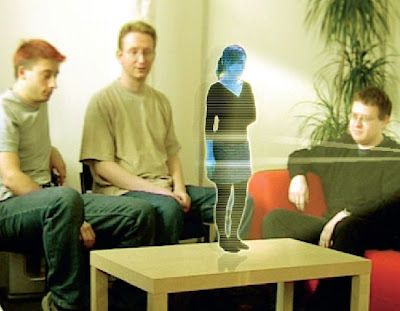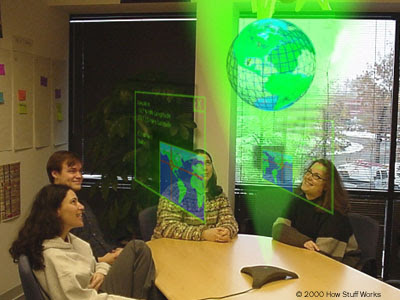全息照相原理基础
来源:互联网 发布:linux windows cuda 编辑:程序博客网 时间:2024/05/16 08:11
- 来源:http://presentsoftware.blogspot.com/
Hologram Basics:

There are a few basic things to learn about holograms.
First, I will briefly explain the two theories behind the hologram.
1) the wave interference pattern, and 2) the coherency of light.
Then, I will describe how holograms store and project information.
1. Interference Pattern:
The hologram is based upon Nobel Prize winner Dennis Gabor's theory concerning interference patterns. Gabor theorized in 1947 that each crest of the wave pattern contains the whole information of its original
 source, and that this information could be stored on film and reproduced. This is why it is called a hologram.
source, and that this information could be stored on film and reproduced. This is why it is called a hologram.hologram diagram A pebble, dropped in a still pond, is the most basic example used todescribe the wave interference process. If you drop a pebble into a pond, it creates an infinitely expanding circular wave pattern. If you drop two pebbles into a pond the waves' crests would eventually meet. The intersecting points of the waves' crests are called the points of interference. The interference of two or more waves will carry the whole information about all the waves.
2. Coherent Light:
 Gabor recorded several images holographically, but wasn't successful at producing a clear image because he could only use forms of incoherent, white light. An example of incoherent light would be if you were watching cars coming out of a tunnel, you would likely see many different models and types of cars, traveling at different speeds and at different lengths apart. Now, suppose you started seeing the same model and type of cars, all heading down the highway at the same speed, and the same distance apart. This would be an example of coherent light. Holograms need coherent light to record or playback the image clearly.
Gabor recorded several images holographically, but wasn't successful at producing a clear image because he could only use forms of incoherent, white light. An example of incoherent light would be if you were watching cars coming out of a tunnel, you would likely see many different models and types of cars, traveling at different speeds and at different lengths apart. Now, suppose you started seeing the same model and type of cars, all heading down the highway at the same speed, and the same distance apart. This would be an example of coherent light. Holograms need coherent light to record or playback the image clearly. 
The L.A.S.E.R. (Light Amplified by Stimulated Emission of Radiation) was invented to produce coherent light. Incoherent light travels in different frequencies and in different phases. Coherent light travels in the same frequency and in the same phase. (100% coherent light is rare) It is important to use light which is coherent because the information is carried on the crest of each wave. The more points of intersection, the more information.
3. Storing Information:
Unlike a camera, which has only one point of light reference, a hologram has two or more points of light references. The intersection points of the two light waves contain the wholeinformation of both reference points. A LASER is used as the light source so the waves are coherent.

A LASER is projected onto a partially silvered mirror called a beam splitter. This mirror splits the original beam into two beams. One beam travels through a lens that diffuses the light onto the object being recorded. This light, called the object beam, is reflected off the object onto the film plate. The second beam is bounced off a mirror and then through a lens that diffuses the light directly onto the film. This beam is called the reference beam. The same light source needs to be used for both beam so the waves will have perfect intersection points.

To add motion (time) to your holograph, you would turn the object, or move the mirrors and lenses, and shoot again onto the same film. The original waves recorded on the film, will intersect with the waves from the new perspective.

DEC
24
TCP/IP
Posted by Ramesh Coolcomments (0)
 TCP/IP is a set of protocols developed to allow cooperating computers to share resources across a network. It was developed by a community of researchers centered around the ARPAnet. Certainly the ARPAnet is the best-known TCP/IP network. However as of June, 87, at least 130 different vendors had products that support TCP/IP, and thousands of networks of all kinds use it.
TCP/IP is a set of protocols developed to allow cooperating computers to share resources across a network. It was developed by a community of researchers centered around the ARPAnet. Certainly the ARPAnet is the best-known TCP/IP network. However as of June, 87, at least 130 different vendors had products that support TCP/IP, and thousands of networks of all kinds use it. The most accurate name for the set of protocols we are describing is the "Internet protocol suite". TCP and IP are two of the protocols in this suite. (They will be described below.) Because TCP and IP are the best known of the protocols, it has become common to use the term TCP/IP or IP/TCP to refer to the whole family. It is probably not worth fighting this habit. However this can lead to some oddities. For example, I find myself talking about NFS as being based on TCP/IP, even though it doesn't use TCP at all. (It does use IP. But it uses an alternative protocol, UDP, instead of TCP. All of this alphabet soup will be unscrambled in the following pages.)
The most accurate name for the set of protocols we are describing is the "Internet protocol suite". TCP and IP are two of the protocols in this suite. (They will be described below.) Because TCP and IP are the best known of the protocols, it has become common to use the term TCP/IP or IP/TCP to refer to the whole family. It is probably not worth fighting this habit. However this can lead to some oddities. For example, I find myself talking about NFS as being based on TCP/IP, even though it doesn't use TCP at all. (It does use IP. But it uses an alternative protocol, UDP, instead of TCP. All of this alphabet soup will be unscrambled in the following pages.)The Internet is a collection of networks, including the Arpanet, NSFnet, regional networks such as NYsernet, local networks at a number of University and research institutions, and a number of military networks. The term "Internet" applies to this entire set of networks.
TCP/IP is a layered set of protocols. In order to understand what this means, it is useful to look at an example. A typical situation is sending mail. First, there is a protocol for mail. This defines a set of commands which one machine sends to another, e.g. commands to specify who the sender of the message is, who it is being sent to, and then the text of the message. However this protocol assumes that there is a way to communicate reliably between the two computers.
 Mail, like other application protocols, simply defines a set of commands and messages to be sent. It is designed to be used together with TCP and IP. TCP is responsible for making sure that the commands get through to the other end. It keeps track of what is sent, and retransmitts anything that did not get through. If any message is too large for one datagram, e.g. the text of the mail, TCP will split it up into several datagrams, and make sure that they all arrive correctly. Since these functions are needed for many applications, they are put together into a separate protocol, rather than being part 5 of the specifications for sending mail.
Mail, like other application protocols, simply defines a set of commands and messages to be sent. It is designed to be used together with TCP and IP. TCP is responsible for making sure that the commands get through to the other end. It keeps track of what is sent, and retransmitts anything that did not get through. If any message is too large for one datagram, e.g. the text of the mail, TCP will split it up into several datagrams, and make sure that they all arrive correctly. Since these functions are needed for many applications, they are put together into a separate protocol, rather than being part 5 of the specifications for sending mail. - 全息照相原理基础
- 基础原理
- 变频器基础原理
- jsp基础原理
- android基础进度条原理
- 一、杀毒软件原理基础
- ADI加速度计基础原理
- 编译原理基础:文法
- DHCP协议原理基础
- VPN原理基础
- 计算机组成原理基础
- java基础---JNI原理
- NMOS/PMOS原理基础
- 编译原理基础
- UVA11401基础计数原理
- 磁盘阵列raid基础原理
- 网络通讯原理基础
- 编译原理基础
- Android流量统计代码
- VC 6.0 常见断言错误总结
- 快速排序的几种C++实现
- 索引与优化like查询
- WinCE蓝牙驱动
- 全息照相原理基础
- ajax跨域的实现
- java keytool 使用总结(转)
- How to Perfectly Uninstall RoboForm
- 格拉姆-施密特正交化Gram-Schimidt
- cocos2d 的Action 如何在 scene 切换间自动播放和暂
- 第八周实验报告(1)
- PowerPoint嵌入YouTube视频
- Activity加载模式和常用flag


